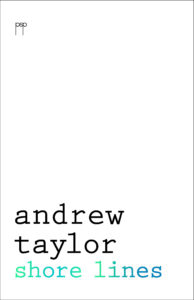
- Free Article: No
- Contents Category: Poetry
- Review Article: Yes
- Article Title: Plover's lament
- Article Subtitle: A celebration of continuity
- Online Only: No
- Custom Highlight Text:
Andrew Taylor has been an important figure in the Australian poetic landscape since his first book, The Cool Change, appeared in 1971. Identified with no particular group or aesthetic tendency, he has worked as poet and academic in Melbourne, Adelaide, and Perth, and is now retired from teaching and based in Sydney.
- Featured Image (400px * 250px):

- Alt Tag (Featured Image): Geoff Page reviews 'Shore Lines' by Andrew Taylor
- Book 1 Title: Shore Lines
- Book 1 Biblio: Pitt Street Poetry, $28 pb, 108 pp
- Book 1 Cover Small (400 x 600):

- Book 1 Cover (800 x 1200):

The book is divided into six untitled thematic sections, with the first and the penultimate ones focusing mainly on family history and the central two ranging over various landscapes, particularly their wildlife and weather. ‘Section IV’, like a series of watercolours perhaps, is confined to Coogee, the Sydney beachside suburb where he has lived for the past few years.
In his eighties now, Taylor is understandably interested in what remains and what has vanished of his family’s history in Warrnambool, his birthplace. Something of the dominant feeling here is captured in the opening lines of his poem, ‘Home Town’: ‘The cliffs I rode my bike along / are gone now. Sandstone’s so soft / they’ve crumbled into the surf / that pushes at them from Antarctica.’ After noting the transience of various buildings, Taylor circles back to the sea: ‘relentless, cold as ever / slapping the sand, grinding away the cliffs.’
Another poem in this opening section, ‘Where Are They?’, interestingly begins with an issue mainstream Australian poetry often bypasses: ‘Where are they / who left these shells centuries / thousands of years on this slope / above the rich rock shelves / at the river’s mouth?’
Unfortunately, this approach also has a way of underestimating how successfully ‘those who left the shells’ have survived what was done and continues to be done to them. There is an almost Tennysonian ring to the final stanza: ‘Where are they / whom we hear in the plover’s lament / in the wind’s whisper and the distant / insistent rumour of surf / on the empty beach?’
The next section starts rather differently with a clever poem on ‘Weather’ (‘weather is a shape of waiting / that’s forever on the move like the wind …’) and ends with an even cleverer one, ‘The Engineer of Clouds’. Here Taylor posits a kind of weather god who is ‘grounded firmly / in the physics of turbulence’ and whose ‘favourite painter is Constable’. Understandably, this ‘engineer’ likes to ‘stand drenched in a downpour / fingering the rain drops as a cloud / comes down to embrace him’.
In the book’s third section is a number of more ‘serious’ poems, several of them elegies. They include a tribute to Peter Porter (‘Visiting Peter’, first published in ABR), which begins playfully enough: ‘I should have seen / all those words crowded at the door / of Peter’s apartment when I stayed with him – /so many jostling verbs / outstretched adjectives / nervy adverbs all / rubbing shoulders with those little ands and buts and ors etc.’ A few lines later, Taylor affectingly shows the poet at work: ‘until with patience / and a homemade miracle / their jumble would subside / and they would converse with him / and later, on the page / with us.’ It’s a light touch that Porter himself would have enjoyed – and so often employed.
‘Visiting Peter’ is immediately followed by ‘Lycidas Adieu’, which some might resist as ‘yet another poem about poetry’. To this reader it nicely embodies the ambivalence that most poets feel about their work and its destiny. It opens with ‘What a relief! having no poems to write’ and then goes on to add: ‘I’ve left my words / back on the beach’ and rejoice in the feeling of ‘Sheer blessed emptiness’. ‘These waves will float me out to sea and all my books / will follow me into oblivion.’ Of course, the reader knows that the poet almost certainly doesn’t think this. He expects that a handful of his poems will survive in anthologies for a hundred years or more, but the mood, along with Taylor’s evocation of it, is persuasive enough.
Happily, like its predecessor, this third section also balances a ‘lightness’ with more moving poems, one of these being ‘Sydney to Lima’, where the poet would appear to be telling the story of how he flew to Lima to bring home his wife who had become almost fatally ill there. Affectingly, he does not mention the relationship explicitly, thus helping to give the poem a universality it mightn’t otherwise have had.
Other stressful events in the book which deserve mention are the 2019 bushfires and the Covid lockdowns which began not long after. Almost all Australian poets at the moment have their poem or two (if not whole chapbooks) on these events. Some, but not many, are compelling. Most of the latter, like Taylor’s, demonstrate the value of understatement and indirection. His ‘From the headland’, for instance, ends on an optimistic note: ‘Yet today on the headland, banksia / melaleuca and spidery grevillea / are shaken by honeyeaters / and I can see the whales, their white / exuberant flotilla, forging / north, as they always do, to breed.’
In a sense, almost the whole of Shore Lines is a celebration of such continuity.


Comments powered by CComment